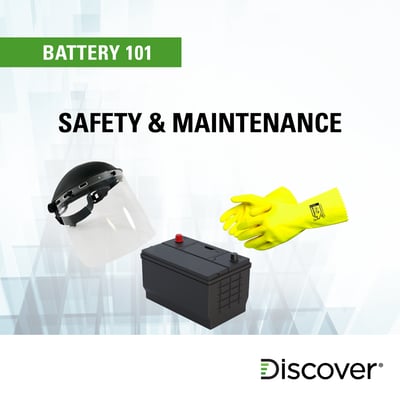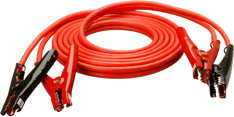How to handle batteries safely while performing any installation or maintenance is important but often forgotten.
The latest in our battery 101 series, we explore safety and maintenance of batteries.
Safety and Productivity
Purchase decisions are being made by safety supervisors, legal teams and cost accountants. Mining operations, transit companies, cities, hospitals, schools, airport authorities and manufacturing organizations are all required to implement rigorous risk management and environmental impact programs. These programs enable them to manage workplace hazards that may affect their employees, their communities and their environments. Failure to do so can result in injury and lead to civil or even criminal charges.
Discover sealed, maintenance free, non-hazardous batteries are LEED certified and can help purchasers reduce these risks and improve their environmental performance. Discover has responded to the needs of these industries for sealed non-spill able non-hazardous batteries in drop in replacement sizes. Discover batteries meet the environmental and occupational health and safety compliance needs and – over the life of the product – save users money and time in service costs and compensation claims.
When working with batteries
Remember, safety first when working with batteries!
- Always wear proper eye, face and hand protection
- Keep sparks flames and cigarettes away from the battery
- Do not remove or damage the vent caps on sealed valve regulated types
- Do not open in any way Sealed Valve Regulated batteries
- Cover vents with a damp cloth to minimize gas seepage
- Make sure work area is well ventilated
- Never lean over battery while testing, boosting or charging
When handling battery acid
When handling battery acid, always wear proper eye, face and hand protection.
- Battery acid (electrolyte) is a solution of sulfuric acid and water that can destroy clothing and burn skin. Use extreme caution when handling electrolyte and keep an acid neutralizing solution – such as baking soda or even household ammonia mixed with water – readily available in the event of a spill
- You can add acid to water, but you can never add water to acid
- Always wear eye protection; if electrolyte is splashed into the eye, immediately force the eye open and flood with clean cool water. Get medical attention immediately
- If electrolyte is somehow taken internally, drink large amounts of water or milk. DO NOT induce vomiting. Get medical attention immediately
- Neutralize with baking soda any electrolyte that spills in the work area, rinse with water
When installing or replacing batteries
To install or replace a battery, follow the manufacturer's instructions or read through the list below for a guide:
- Disconnect ground cable (negative cable) first
- Note position of Positive (+) and negative (-) cables. Mark cables for correct connection to the new battery
- Remove old batteries
- Clean terminals and cable connections. Broken, frayed, brittle, kinked or cut cables should be replaced
- Clean and/or paint and repair battery compartment and hold down
- Install and secure the new battery. Be careful not to ground the terminals on any metal mounting, fixture or body part
- Connect the cables tightly. Connect the ground cable last to avoid sparks
When booster cables are used
- When jump starting, always wear proper eye protection
- Never lean over the battery
- Do not jump start a damaged battery
- Do not jump start a frozen battery
- Inspect both batteries before connecting booster cables. Be sure vent caps are tight and level, place a damp cloth over the vents of both batteries
- Make sure the vehicles are not touching
- Make sure both ignition switches are turned to the off position
- Connect positive (+) booster cable lead to the (+) terminal of the discharged battery
- Connect the other end of the positive (+) booster cable to the positive (+) terminal of the boosting battery
- Connect the negative (-) cable to the negative (-) terminal of the boosting battery
- Make the final connection of the Negative (-) cable to the engine block of the stalled vehicle, away from the battery. If this is not possible be careful when connecting the negative (-) cable to the discharged battery as the electrical current may jump at the discharged terminal creating a spark
- Start vehicle and remove cables in the reverse order of there connection
Danger of exploding batteries
All Lead Acid Batteries contain sulfuric acid.
Flooded or wet lead acid batteries produce explosive mixtures of hydrogen and oxygen when charging and discharging. Because self-discharge action can generate hydrogen gas even when the battery is not in operation, make sure batteries are stored and worked on in well ventilated areas. Always wear safety glasses and a face shield when working on or near batteries.
Discover Valve Regulated Deep Cycle and Traction Batteries are sealed and maintenance free and all sulfuric acid is immobilized and absorbed, and under normal operating conditions any gas produced is recombined and is not vented to the atmosphere.
All lead acid batteries – including sealed valve regulated batteries will vent gases if over charged.
Warning labels & symbols
These international warning symbols are located on the product labels of all Discover batteries. Lead acid batteries can be extremely dangerous if mishandled. All of our batteries must contain warning information to help protect consumers against injuries.
Battery Labels
 |
Do not add water. Do not add electrolyte. Discover® products have a recognized gas recombination efficiency of greater that 99.9% and are sealed, non-spillable and maintenance-free. |
 |
Do not tamper with product labeling, container or vents. Warranty is VOID if product is tampered with. |
 |
Do not throw in the garbage. Discover® is a 98% recyclable product and must be processed via a recognized recycling agency. |
 |
High voltage. Risk of shock. Do not touch uninsulated terminals or connectors. |
 |
This product must be recycled and is made of recycled products. Contact a Discover® representative for collection and recycling. |
|
|
Contains lead. California Proposition 65 Warning: Battery posts, terminals, and related accessories contain lead and lead components, chemicals known to the State of California to cause cancer and reproductive harm. Wash hands after handling. |
Warning Symbols
 |
Danger. Poison. Keep out of reach of children, do not tip and do not open the battery. |
 |
Shield Eyes. Explosive gases can cause blindness or injury. |
|
|
Flush eyes immediately and seek medical information right away. |
 |
Sulfuric Acid can cause blindness and/or severe burns. |
 |
No sparks, flames or smoking near battery. |
| Note: The warning symbols and content contain the most current language as specified by the BCI. | |











